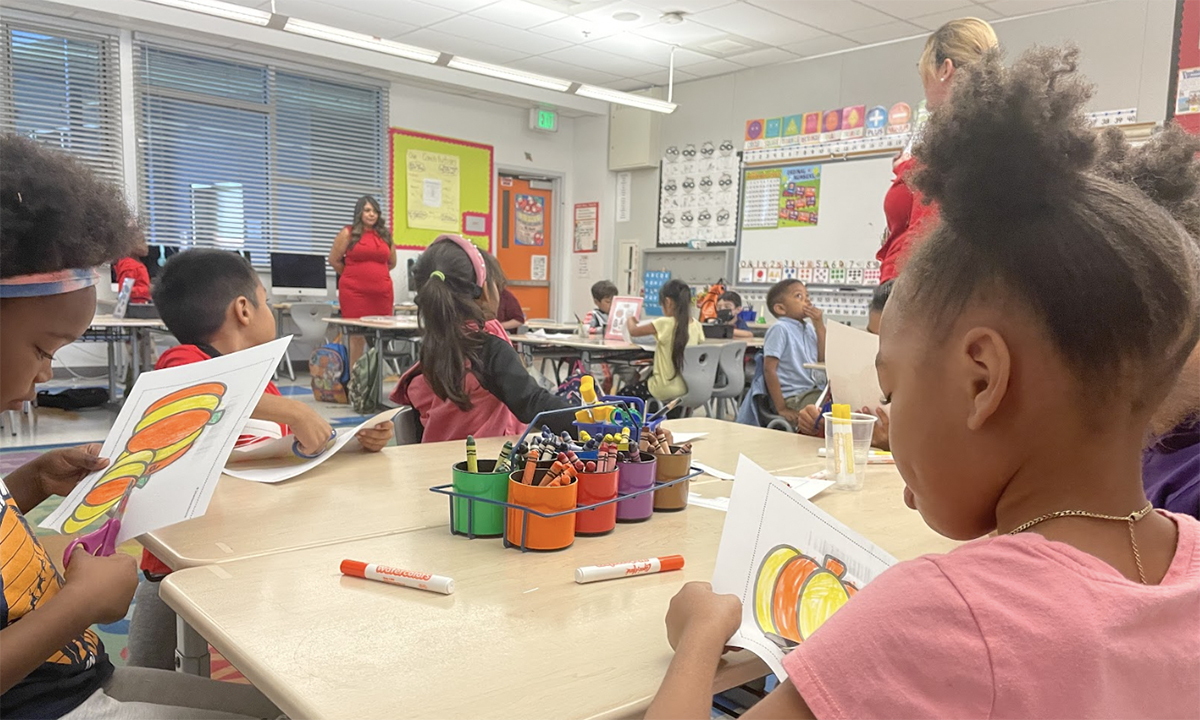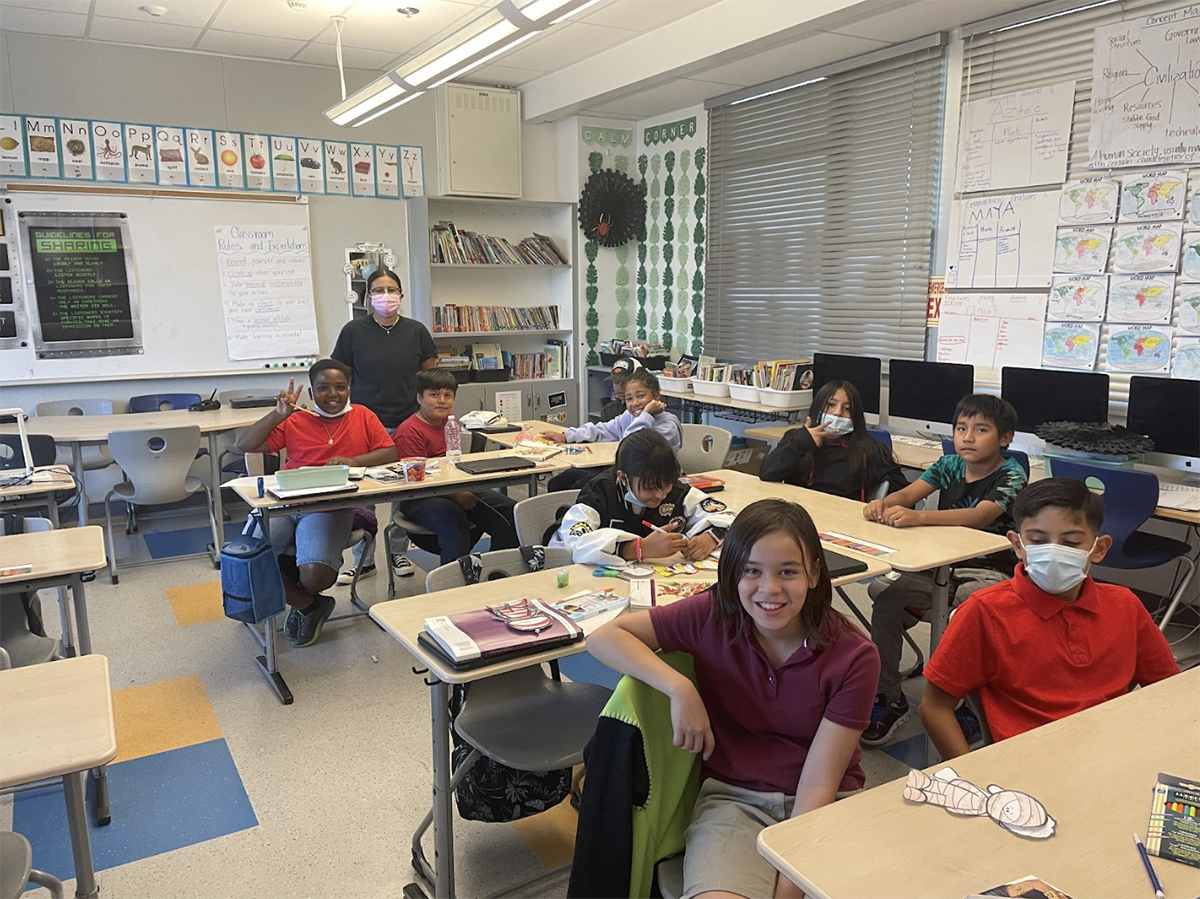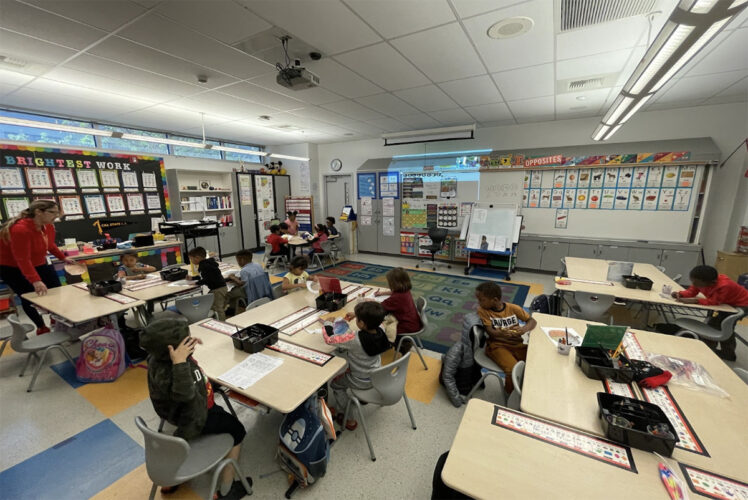Taking Care of Her ‘Babies’: How One LAUSD Principal Provides Pandemic Recovery to Vulnerable Kids
LAUSD plans to launch targeted support for schools that continue to experience deep learning loss

Get stories like this delivered straight to your inbox. Sign up for The 74 Newsletter
During the pandemic, Los Angeles Unified’s Ninth Street Elementary School teachers saw their students attending remote classes from crowded and noisy shelters — or living with more than ten family members in a small room.
Located in one of Los Angeles’ lowest income neighborhoods, Ninth Street Elementary enrolls students who live in the Fashion District bordering Skid Row, with 24% of their students homeless and 51% of students English Learners.
Because of their family circumstances, Ninth Street principal Jeanette Reyes realized many of her students were coming to school hungry. Reyes, a first year principal, had a solution.
“My cafeteria is open all day in case my babies are hungry,” Reyes said. “They can come and they can eat.”
The effects of the pandemic along with food insecurity and other issues contributed to deep learning loss in at least 100 LAUSD schools with similar student populations to Ninth Street. Now, the district is launching targeted support for the schools’ recovery.
LAUSD selected Ninth Street Elementary as part of the effort after students’ scores on state tests made the school among the lowest achieving in the district.
After a difficult year of online learning, Ninth Street students who entered kindergarten during the 2109-20 school year and were back in person for second grade were among those who experienced the biggest academic losses.
Ninth Street Elementary second grade teacher Vanessa Estrada said many of her students are unable to write their first and last name, a skill taught in kindergarten.
“[They] missed out on all those experiences,” said Estrada. “It’s not the same on the computer as it is in person.”
Ninth Street students were especially hard hit because most students lacked the resources, such as laptops and reliable wifi, to learn at home.
“Having the camera on and for (educators) to see that there are ten different people in the same room. Small children and older children,” said Reyes. “That was very hard.”

Preschool and kindergarten students suffered during the pandemic as “pandemic babies. They’ve been at home…cooped up and they don’t know what coming to school is like,” said Lillia Guerro, a preschool and kindergarten teacher at Ninth Street.
“We’re a family. We’re all here for the same common goal, which is our students. It takes every single piece of this puzzle to make this puzzle complete,” Reyes said, adding how most of the teachers at the school have two years of experience or less.
Here are some key strategies that Ninth Street has implemented to help students recover from the pandemic:

1. Extended tutoring
For the first time, Ninth Street Elementary implemented summer school and Saturday school for the second year.
Reyes praised the commitment of her teachers, adding that all staffers scheduled to work on those days were present and participated enthusiastically — despite half of them being new to teaching.
“I cannot ask for more,” Reyes said.

2. Creating support systems with families
Many teachers said parent involvement and communication were important to the success of their children.
“That’s one of my big things is communicating with parents about their (childrens’) academics,” said Estrada, who works with first-grade students’ parents.
To communicate with parents, teachers use platforms such as Class Dojo, especially for younger students, sharing photos, videos, and multiple language translations.
“This is what your child needs help on…that’s really where we do a lot of the talking about standards, talking about where your child is, where they need to be, and what are the steps that we need to follow to get them there,” said Guerro.
The school has also incorporated coffee with the principal and hosted parent workshops to develop relationships between parents and school administrators.
Most recently, Ninth Street created a book club designed for fifth-grade parents to read the same books that their children are reading to support them.
“What I want is for the parents to have a clear picture of what the students are doing, what they’re learning, and how they are struggling…It’s all about building…those relationships with them so that they can trust us,” Reyes said.

3. Differentiated learning and assessment
Ninth Street Elementary is using a system known as DIBELS (Dynamic Indicators of Basic Early Learning), to monitor progress to pinpoint the skills students are most missing.
Depending on their score, these students are placed into four categories: Intensive, Strategic, Benchmark, and Challenge.
“There was a decline in academic performance. We cannot deny it, but we’re working towards improving that,” Guerro said.

4. Providing technology, necessities, and emotional help
“As for my students, they suffered a lot,” Reyes said, adding that is why the school has put into place resources to help students who experience food and housing insecurity.
“Having resources…so that if a child comes in with sandals, I can provide shoes or backpacks. The bare necessities that they need,” Reyes said.
Emotional support and mental health has also become a priority at Ninth Street. A full time social worker visits classrooms providing lessons on mental health.
“I was an inner-city student myself. I went to elementary, middle school, and high school down the street right here in South L.A. It gives my students the opportunity to understand that a person that looks like them…that came from the same upbringing can become a principal,” Reyes said. “That means that the world is their oyster. They can accomplish anything they want.”

This article is part of a collaboration between The 74 and the USC Annenberg School for Communication and Journalism.
Get stories like these delivered straight to your inbox. Sign up for The 74 Newsletter

;)